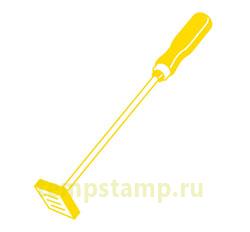Cylindrical seal
Even the inhabitants of Mesopotamia perfected miniature sculpture, or glyptic art (from the Greek “glyphein”, “cut”). The most prominent cultural objects are the small cylindrical seal, which is an engraved cylinder , which is usually rolled on soft clay to leave an imprint that served as a signature or sign of possession. Although cylindrical prints were used throughout the ancient Middle East, where the influence of Mesopotamia is deeply felt, no other civilization in the world has invented and brought this art form to such a degree of perfection.
History
Using stamps (in Sumerian "kishib"; in Akkadian "kunukku") for from tags on clay for the first time belongs to the eighth millennium BC These seals appeared in Syria, where they might have served decorative or magical purposes. These seals were not cylindrical, but round and were used in the way that rubber stamps are now used . By the middle of the sixth millennium BC similar seals were used on the territory of present-day northern Iraq for applying a linear pattern or forms on clay tags disks for identification purposes.
Judging by the imprints on the clay to the fourth millennium BC. This refers to the type of seals used by the Sumerians in southern Mesopotamia. The introduction of these seals precedes the birth of the letter, but coincides with the discovery of metallurgy, since metal tools were required for engraving on the stone.
Cylindrical seals have many advantages over their predecessors, seals for stamps. When they were rotated, they could cover a large area. Their large surface made it possible to have more space for patterns, which guaranteed the individuality of each individual print and, thus, its effectiveness as a sign of personal identification and personal possession. After the appearance of the letter, a large surface was useful for placing the name of the owner . A more extensive picture also corresponded to the aesthetic views of the inhabitants of Mesopotamia. The complex imprint of a cylindrical seal was also more impressive than a stamp print, and the engraved scenes made the imprint a true work of art. Except that they were hard to fake.
For three thousand years, from Sumerian times to the days of the Persian Empire, cylindrical seals surpassed seals in the form of stamps in popularity. But by about 1000 BC they gave way to stamps, which acquired to the V century. BC. complete domination. The reason was a change in language and writing. Aramaic ousted Akkadian as an international language in the Middle East. While Akkadian was recorded in the form of cuneiform on clay tablets, Aramaic was written with ink on papyrus, parchment, or leather, with the scrolls twisted and tied with a rope, on which a small piece of clay was hung for safety. Since there was no longer a place on which it was necessary to roll a cylindrical seal, it disappeared from everyday life.
Making
The task of making seals lay on the seal carvers. The discipleship of the master for the production of seals lasted four years, the master and the students worked in the workshop; one of these workshops was found in the ruins of the Syrian city of Ugarit. A toolkit was found in Tell Asmara, east of Baghdad. A small copper cutter, two pointed copper engravers were found in the earthenware jug (for working out the details), usually a drill (for making holes), and several unfinished seals. Tools for engraving were also made of bronze and silicon.
Drill and thread blades were manually actuated. The carver moved the bow back and forth, tied around the shaft of the string, forcing him to rotate, too, back and forth. Later, perhaps, legs were used in order that the shaft rotated constantly and in one direction. Apparently, the carvers purchased from the merchants not raw stones, but finished cylinders with a smooth surface.
When the cylindrical seal was ready (and perhaps even before that), holes were drilled in it from the bottom and top to form a through channel. A rope was inserted into this canal, so that the seal could be worn on the rope around your neck as a pendant.
Materials
Most of the cylindrical seals were carved from stone, mostly brought from other countries. But some seals were made from other materials, such as bone, ivory, shells, wood, clay and metal (gold, silver, copper and bronze).
At different times, different types of stones were used, depending on the vagaries of fashion and the availability of stones from local and foreign sources. The very first seals were carved from soft sandstone, lapis lazuli and rock crystal. Later they began to use stones of different shades, such as diorite, talc and agate of different colors. Serpentine, chlorite, jade and green as apple amazonite, red carnelian, dark red goethite and red and white spotted jasper, purple amethyst, black limestone, magnetic iron and glassy obsidian were used for brighter colors. Quite late in the history of the production of seals, synthetic stone — composite quartz — was used.
It was believed that some stones have magical properties and benefit their owners: lapis lazuli symbolized power and success, rock crystal gave happiness, green marble guaranteed a constant blessing of the gods. According to Assyrian dream interpreters, if in a dream they give a seal, then this means the birth of a son.
If at the same time the figures are engraved on the seal, then it promised many sons and peace of mind. The red seal was the forerunner of sons and daughters. The ivory seal gave fulfillment of the cherished desire, and the royal seal served as protection of the gods.
Decorative themes
When creating reliefs on the press used a lot of topics. Different times corresponded to the popularity of different topics.
The earliest topics were economic. Products and fabrics were depicted on seals. Later began to be depicted and religious ceremonies. Thus, on the earliest seals there are two interrelated themes: material prosperity and godliness. In the early Dynastic period, perhaps to commemorate the heroic achievements of the epoch, new themes emerged: the battles of mythological characters and feasts. Somewhat later, the gods appeared. In the following centuries, their place on the miniature scene was taken by heroes and monsters, gods and kings.

Use of seals and their owners
Mesopotamian seals were used in many different cases. Before the advent of writing, they marked empty clay balls into which they were placed small clay labels , which symbolized goods ( for example, sheep) used in commercial transactions. Later, seals were used to seal pots with valuable goods: the neck of the pot was covered with a rag and tied with a rope, the knot was sealed in clay, and clay was stamped . Similarly, printing was applied to the doors leading to the warehouses. However, most often the seal was used as a kind of signature to the documents on the clay, rolling it through a tablet or through a clay envelope in which the document was located.
Sometimes, for greater accuracy, the impression of the seal was supplemented with an inscription in cuneiform indicating the name of the owner. Additional data could include the owner’s father’s name, owner’s title and / or profession, and the names of the ruler or god he served. Such inscriptions, apparently, were added to the print when buying the ordered print. In this case, put the name of the buyer, usually in a specially reserved place. From this kind of inscriptions, we know that people of various professions and different social status owned and used cylindrical seals: men and (less often) women, rulers and priests, soldiers and scribes, royal cooks and servants, carpenters and other craftsmen, as well as the ubiquitous merchants. Even the slaves who carried out the transactions had stamps. The gods were also depicted with stamps. The same person could have several seals, ordering a new one when promoted or moving to the service of another ruler.
Reprints of stamps were found in contracts, contracts and letters. In order to obtain a loan, the borrower or his representative had to roll the seal under his obligation to return a certain amount. When transferring the property, the seller had to sign the invoice for the sale. Upon receipt of the goods, the recipient also had to sign the corresponding document. In the case of mutual obligations - for example, a wedding or a business agreement - both parties had to sign. By the middle of the first millennium BC when drafting documents, they began to make a copy so that each side would have a copy — it is exactly the same today.
If cylindrical seals were lost or stolen, they were taken very seriously. The former owner recorded the time and date of the loss in the presence of an official, thereby certifying the fact that all sales and purchases using this stamp are invalid (this is very similar to what happens when the owners of Visa or Mastercard report lost or stolen credit card.)
Our masters will make a cylindrical seal no worse than their ancient colleagues. Nowadays, cylindrical seals have been transformed into industrial shafts and embossing rollers . & Nbsp;
Стивен Бертман / Месопотамия. — М. : Вече, 2007. — 416 с. — ISBN 978-5-9533-1916-4


